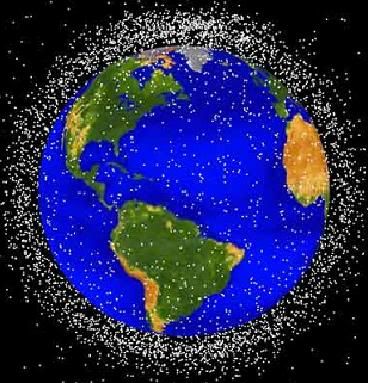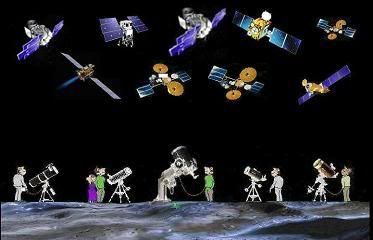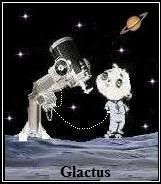Post by glactus on Dec 12, 2011 0:48:01 GMT
Space is filling up with trash, and it's time to clean it up, NASA experts warn. A growing amount of human-made debris—from rocket stages and obsolete satellites to blown-off hatches and insulation—is circling the Earth. Scientists say the orbital debris, better known as space junk, poses an increasing threat to space activities, including robotic missions and human space flight.

Space debris orbiting the Earth
"This is a growing environmental problem," said Nicholas Johnson, the chief scientist and program manager for orbital debris at NASA in Houston, Texas. Johnson and his team have devised a computer model capable of simulating past and future amounts of space junk. The model predicts that even without future rocket or satellite launches, the amount of debris in low orbit around Earth will remain steady through 2055, after which it will increase.

Types of space junk in orbit
While current efforts have focused on limiting future space junk, the scientists say removing large pieces of old space junk will soon be necessary. Researchers present an overview of the space junk problem in tomorrow's issue of the journal Science. Since the launch of the Soviet Union's Sputnik I satellite in 1957, humans have been generating space junk.

The Astronomy club looking at orbiting satellites
The U.S. Space Surveillance Network is currently tracking over 13,000 human-made objects larger than four inches (ten centimeters) in diameter orbiting the Earth. These include both operational spacecraft and debris such as derelict rocket bodies.
Of the 13,000 objects, over 40 percent came from breakups of both spacecraft and rocket bodies,.
To see 2 minute and 42 second video of ideas on how to fix the Space Junk problem just click on the link below. Has sound. Full screen option bottom right.
www.youtube.com/watch?v=IA-Ms1RUrPw&feature=related

Credits: These are non copywrite images
Text by NASA
Special credit:Nicholas Johnson, NASA scientist and program manager
Space art by Glactus
Video by YouTube

Space debris orbiting the Earth
"This is a growing environmental problem," said Nicholas Johnson, the chief scientist and program manager for orbital debris at NASA in Houston, Texas. Johnson and his team have devised a computer model capable of simulating past and future amounts of space junk. The model predicts that even without future rocket or satellite launches, the amount of debris in low orbit around Earth will remain steady through 2055, after which it will increase.

Types of space junk in orbit
While current efforts have focused on limiting future space junk, the scientists say removing large pieces of old space junk will soon be necessary. Researchers present an overview of the space junk problem in tomorrow's issue of the journal Science. Since the launch of the Soviet Union's Sputnik I satellite in 1957, humans have been generating space junk.

The Astronomy club looking at orbiting satellites
The U.S. Space Surveillance Network is currently tracking over 13,000 human-made objects larger than four inches (ten centimeters) in diameter orbiting the Earth. These include both operational spacecraft and debris such as derelict rocket bodies.
Of the 13,000 objects, over 40 percent came from breakups of both spacecraft and rocket bodies,.
To see 2 minute and 42 second video of ideas on how to fix the Space Junk problem just click on the link below. Has sound. Full screen option bottom right.
www.youtube.com/watch?v=IA-Ms1RUrPw&feature=related
Credits: These are non copywrite images
Text by NASA
Special credit:Nicholas Johnson, NASA scientist and program manager
Space art by Glactus
Video by YouTube


